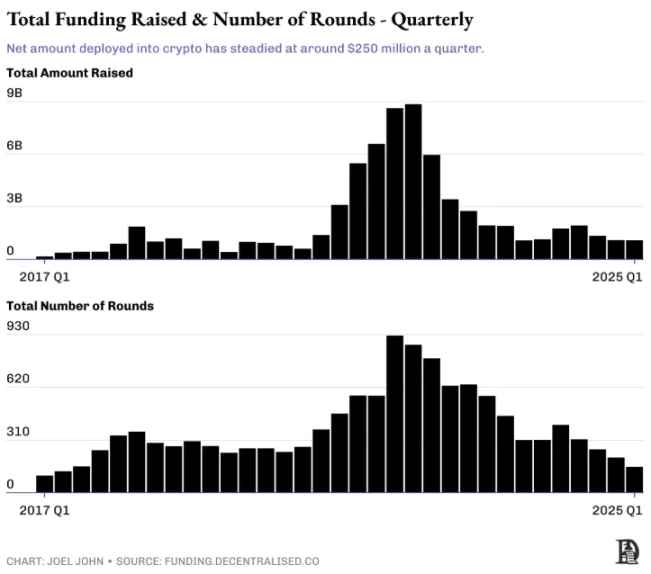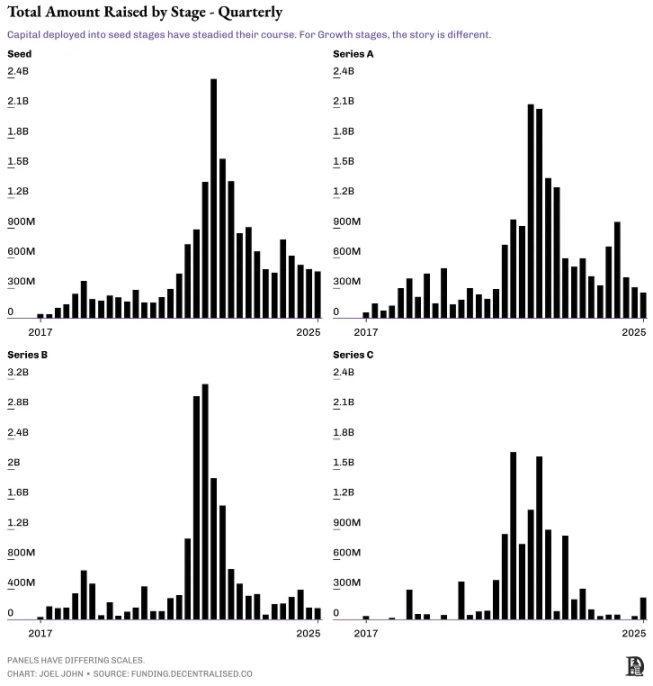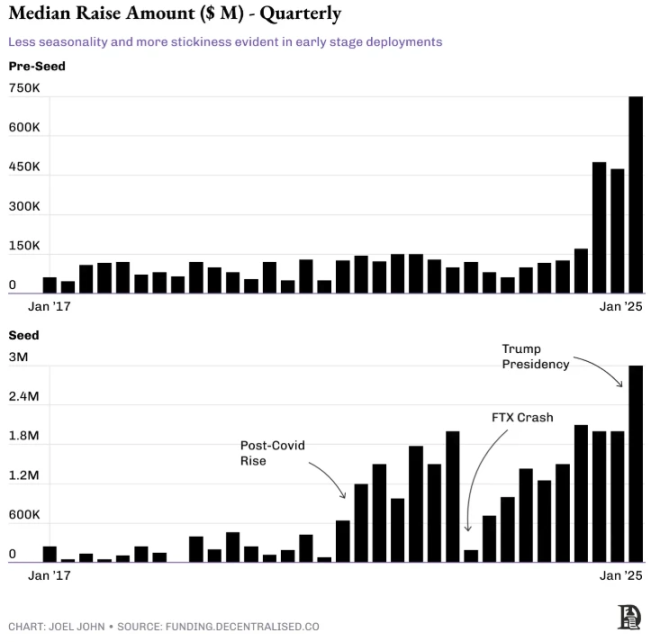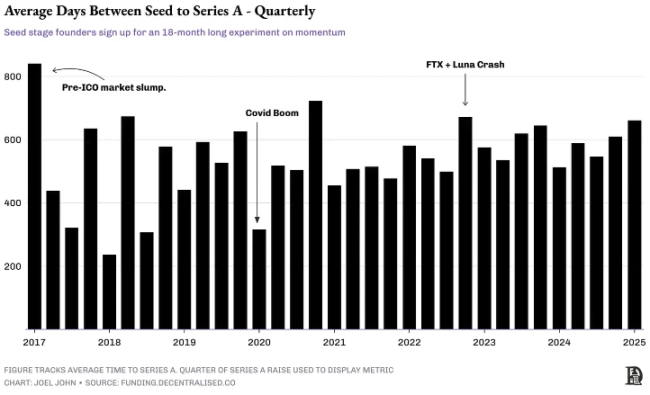Exploring the situation of crypto venture capital and future expectations: the final stage of fanaticism

Reprinted from panewslab
03/24/2025·2MWritten by: decentralised
Compiled by: Odaily Planet Daily Golem
All data comes from Funding Tracker.
Crypto venture capital status
Rational market participants may think that the capital market also has climaxes and ebbs, just like other things in nature that have cycles. However, cryptocurrency venture capital seems more like a one-way waterfall—a gravity experiment that continues to fall. We may be witnessing the final stages of a craze for smart contract and ICO financing in 2017, accelerating in the era of low interest rates in the coronavirus pandemic and is now back to a more stable level.

Total financing and total financing rounds
At its peak in 2022, cryptocurrencies invested $23 billion, and in 2024, that figure dropped to $6 billion. There are three reasons for this:
- The 2022 boom has led VCs to allocate too much money to cyclical and extremely high-valuation projects. For example, many DeFi and NFT projects fail to pay off. OpenSea's peak valuation is US$13 billion.
- It will be difficult for the funds to raise funds from 2023 to 2024, and projects listed on exchanges will also be difficult to obtain the valuation premium seen from 2017 to 2022. The lack of premium makes it difficult for funds to raise new funds, especially when many investors do not outperform Bitcoin.
- As AI becomes the next key technological frontier, large-scale capital has shifted its allocation focus. Cryptocurrencies lose the speculative momentum and premium it once had as the most promising cutting-edge technology.
Another deeper crisis becomes apparent when studying which startups develop enough to guarantee a Series C or D financing. Many large exits in the crypto industry come from token listings, but when most token listings are on a negative trend, investors' exits become difficult. This comparison will be obvious if the number of companies that continue to seed stages of Series A, B or C financing is taken into account.
Since 2017, of the 7,650 companies that received seed round financing, only rose to Series A (graduation rate of 17%) in 1317, with only 344 companies reaching Series B, with only 1% entering Series C monthly, and the odds of Series D financing are 1/200, which is comparable to the graduation rate of financing in other industries. It should be noted, however, that many growth stage companies in the crypto industry bypass traditional subsequent rounds through tokenization, but these data point to two different issues:
- In the absence of a healthy token liquidity market, venture capital in cryptocurrencies will stagnate.
- Without healthy businesses to the later stages and go public, venture capital preferences will decline.
The data from each of the following financing stages seems to reflect the same fact. Although the capital entering seed and Series A financing has been basically stable, the funds in Series B and Series C financing are still relatively conservative. Does this mean that now is a good time for the seed round phase? Not exactly.

Total amount of financing at different stages
The data below tracks the median funding for Pre seed and seed rounds each quarter, which has steadily risen over time. Here are two points of observation:
- Since the beginning of 2024, the median financing in the Pre seed round has increased significantly.
- Over the years, the median seed round financing has been changing with the macro environment.

As demand for early-stage capital declines, we see companies raising larger Pre seed and seed rounds, with the former "Friends and Friends" rounds now being filled by earlier deployments of early-stage funds. This pressure has also expanded to companies in the seed round stage, which has grown since 2022, which can make up for rising labor costs and longer time to reach PMF.
The expansion of the amount of funds raised means that the company will have a higher valuation (or dilution) in the early stages, which also means that the company needs a higher valuation in the future to provide returns. Seed rounds have also seen a sharp rise in the months since Trump's election. My understanding is that Trump’s inauguration changed the environment in which the fund’s GP (general partner) raises funds, with increased interest in LPs and more traditional allocator players, which translates into venture capital preferences for early stage companies.
Financing difficulties, funds are concentrated in a few large companies
What does this mean for the founder? Web3 raises more early stage capital than ever before, but it pursues fewer founders, larger sizes, and requires companies to grow faster than previous cycles.
Since traditional sources of liquidity such as token offerings are now drying up, founders spend more time expressing their reputation and the possibility that the business can achieve. "50% discount, a new round of financing at a high valuation in 2 weeks" has passed. Funds cannot profit from additional investments, founders cannot easily receive a raise, and employees cannot gain value from their vested tokens.
One way to test this argument is through the perspective of capital momentum. The chart below measures the average number of days a startup has raised Series A since the seed round was announced. The lower the number, the higher the capital turnover rate. That is, investors are investing more money in new seed rounds at higher valuations without waiting for the company to mature.

At the same time, based on the above figure, we can also observe how public market liquidity affects the private equity market. One way to observe is through the perspective of "safety", whenever there is a pullback in the open market, the Series A financing will occur on a large scale, such as the sharp decline in the first quarter of 2018, and in the first quarter of 2020, the decline recurs again, which is when the COVID-19 outbreak. When liquidity deployments don’t sound too optimistic, investors with capital to deploy are instead motivated to build positions in the private equity market.
But why was the opposite happening in the fourth quarter of 2022 when the FTX crash occurred? Perhaps it symbolizes the exact time when people’s interest in cryptocurrency investment as an asset class is completely exhausted. Several large funds lost huge amounts of money in FTX's $32 billion financing, which has led to a decline in interest in the industry. In the following quarters, capital gathered only around a few large companies, and since then, most of the capital from LPs flowed into those large companies because it was already where the most funds could be deployed.
In venture capital, capital grows faster than labor force. You can invest $1 billion, but you can't hire 100 people proportionally. So if you start with a team of 10 people and assume you don’t hire more people anymore, you’ll be motivated to get more investments. That's why we can see late-stage financing for a large number of large projects, which are often concentrated on issuing tokens.
How will crypto venture capital become in the future?
I've been following this data for six years, but I'll all come to the same conclusion: raising risk financing can be more difficult. Market fanaticism is initially prone to attract talent and available capital, but market efficiency determines that things can become increasingly difficult over time. In 2018, we can get financing by becoming a "blockchain", but by 2025, we began to focus on project profitability and product-market fit.
The lack of convenient liquidity exit windows means venture investors will have to reevaluate their perception of liquidity and investment. Gone are the days when investors expect to get liquidity exit opportunities within 18-24 months. Now employees have to work harder to get the same amount of tokens, and the valuations of these tokens have become lower. This does not mean that there are no profitable companies in the crypto industry, it just means that just like traditional economies, there will be a few companies that attract the vast majority of economic output in the industry.
If venture capitalists can make venture capital great again, that is, see the nature of the founders, rather than the tokens they can issue, then the crypto venture capital industry can still move forward. Now signaling in the token market, then rushing to issue tokens and hoping that people will buy it on exchanges is no longer feasible.
Under such restrictions, capital allocators are motivated to spend more time working with founders who can take a larger share of the growing market. From the transition from VCs only asking “when to issue tokens” in 2018 to wanting to know what extent the market can develop, it is an education that most capital allocators in web3 need to go through.
But the question is, how many founders and investors will insist on finding the answer to this question?



 chaincatcher
chaincatcher